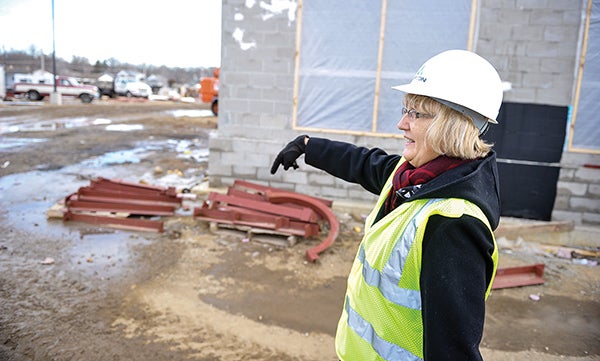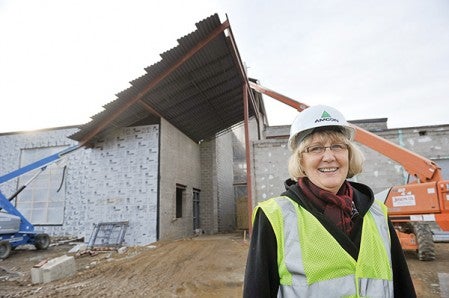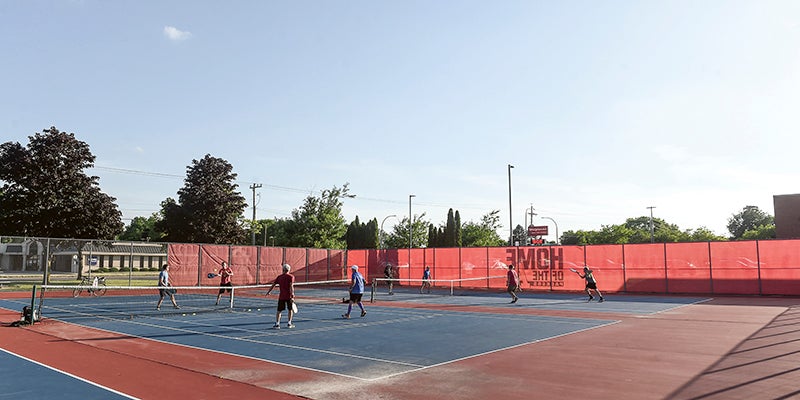Building a future
Published 4:00 pm Friday, March 1, 2013

Jean McDermott points out where the parking lot will be for the I.J. Holton Intermediate School as she walks to where the front exit will be.
Longtime Austin educator Jean McDermott is leading work on I.J. Holton Intermediate School
Jean McDermott is coming full circle this fall.
She’ll be back in a middle school, like the one where she taught math and science for years. She’ll be the principal, just like she was at Woodson Kindergarten Center. She’ll lead teachers and students in new, technological ways, just like she did at Ellis about 10 years ago.
McDermott is hard at work planning the opening of I.J. Holton Intermediate School, which is scheduled for this fall. From the furniture to the classroom lessons, the tiling on the floor to the curriculum organization, she’s spearheading Austin’s biggest education innovation, and arguably will have the biggest impact on Austin’s school system for years to come.
McDermott is an Austin native who graduated from Austin High School in 1974. She has spent more than 20 years as an Austin Public Schools teacher and administrator. Though she spent recent years as the principal at Woodson, her passion lies in educating middle schoolers.
She wasn’t always so sure of that, however. McDermott earned her bachelor’s degree from Bemidji State University in elementary education.
“I really thought I was going to be in elementary [classrooms],” she said. “I was a camp counselor as a high school and college person, and really liked elementary teaching.”
Yet her first teaching job at St. Rose of Lima School in Roseville put her in a middle school classroom, and 10 years later she still loves teaching middle schoolers.
She came to Austin in 1989, teaching for a year at Pacelli Catholic Schools before getting a Title 1 specialist position at Ellis Middle School, where she stayed until 1998. With so much experience at the middle school level, McDermott has an appreciation for what middle school and junior high teachers do.
“Every teacher at every level has a gift,” McDermott said. “You look at kindergarten teachers and see the patience they have to have. … With middle school teachers, again, the patience they have to have to do the work they do is incredible.”
Classroom upgrade
A new school means plenty of new routines to learn. That includes major classroom technology upgrades, as the district may potentially roll out iPads for students in some capacity to solve engineering and science problems, or to use in general music classes, for example. While students will get those technology lessons, teachers will do a bit of learning on their own: I.J. Holton will have its own technology integration specialist to help staff with any Science, Technology, Engineering, Arts and Math, known as STEAM, curriculum questions of their own. The tech integration specialist won’t help with IT-related questions, but rather will help teachers find ways to use technology in lessons.
“The expectation for teachers is that they’ll be implementing a lot more technology into their curriculum,” McDermott said.

Jean McDermott stands outside what will be the main entrance to the I.J. Holton Intermediate School. McDermott is spearheading the building effort and will be principal when the project is complete.
The school will be organized to reflect that tech influence. There will be classrooms in pod areas, meaning classes will be organized so they can open into larger commons areas. In addition, there will be production labs where students can do multimedia-based projects, and McDermott said students will have video production courses at times. Those same production labs will be home to a “tech café” of sorts, where students can use Kindles, e-book readers or other technology before and after school.
That dovetails with what parents, students and community members were looking for in a new school, according to Superintendent David Krenz.
“We’ve tried very hard to make sure we’ve gotten input and participation from the community members,” he said.
Students will have elementary-style scheduling, so lessons throughout the week can be more flexible than a high-school schedule would allow. Though I.J. Holton’s school day will run from 8 a.m. to 2:55 p.m., the same as Ellis, students will be able to explore more of their lessons.
“At a high school, with kids all over the place, if I want to grab 30 kids and do something I’ve disrupted 20 different teachers in the building, and kids need to get to their classes,” McDermott said. “So the ability to [be flexible] is very difficult on a secondary mindset.”
Class sizes should run about 30 students per classroom, and classes will be grouped together in teams, similar to what’s done in fifth grade now. Each of their three main teachers will teach reading lessons in his or her class, and will also specialize in either science, social studies or math.
“Those three teachers will be the adult support for those 90 kids, and those kids will have a majority of those classes with these teachers,” McDermott said.
Sixth-graders will have similar schedules, only there will be four classes grouped into a team.
Students will be introduced to electives as well, since they will have physical education and music two days a week. Each quarter, students will get what McDermott calls “exploratory” courses: keyboard, industrial tech/robotics, and personal wellness classes among others.
Higher learning
The classroom changes reflect a large shift in the school’s educational approach. Most teachers in the U.S. teach according to standards-based lessons, or lessons requiring students to memorize and recall information and processes, which each state tests for every year, more commonly known as state comprehensive testing. I.J. Holton teachers will change things under a STEAM approach, focusing more on critical thinking and having students master the process of learning. In effect, teachers will go one step further in educating students, showing them not only what they need to know but how they can find out other things by themselves.
“It’s going back to inquiry-based learning,” McDermott said. “As you look at standards and testing, because that becomes what’s right in front of you … it’s hard to get all those other things, too.”
McDermott said the inquiry-based curriculum will be a “four-year process,” where teachers will plan more projects and lessons for students each year, slowly transitioning in more units and more hands-on activities. In addition, students will be expected to pursue projects they’re interested in, based on questions they’ve asked, as opposed to projects planned by the teacher. That means students will be introduced to many advanced concepts at an early age, through their own curiosity.
“You want to introduce them to these things so they’ll try it,” McDermott said. “Not that they’ll master it, but so they’re exposed to it.”
Students will still be expected to meet state and federal education standards, but the hope is the critical thinking approach will leave them in a better position to learn in high school and beyond.
“Good teaching is going to hit all those standards,” McDermott said. “The standards will follow.”
That reflects the innovation Austin schools have gone through over the past several years, from a push to individual education plans for each student and new ways to organize lessons, to even promoting positive behavior inside a school.
That doesn’t cover the partnerships the district has formed over the years with local businesses and organizations. Hormel Foods Corp. regularly accepts AHS students for mentorships, and area organizations like The Hormel Institute are partnering with advance-placement bio courses to offer students chances to work alongside scientists while learning at a college level.
Those partnerships should continue, as Austin educators are joining forces with community members on the Vision 2020 “Education Leaders” committee to find more ways the district and the community can intersect. That’s all part of the plan, according to Krenz.
“We don’t believe status quo is OK,” Krenz said. “We believe we need to be finding new and innovative ways to educate our kids. It’s not good enough where we’re at. We want to move forward.”
Getting ready
McDermott expects to start parent meetings this March at each elementary school. Construction workers won’t finish I.J. Holton until mid-August, and school is expected to start on time next year. The school won’t have an official open house until the end of September, as construction will finish just before the school year starts.
Yet there’s plenty to get ready before then: Teachers are finding more things to include in each classroom, from garbage cans to pencil sharpeners. Science teachers are still requesting more items for science labs, and everyone is trying to make sure the school is fully stocked before September.
And guess who’s responsible for those supplies?
“I’m the one who’s going to have to get them,” McDermott said. “I’m getting emails from all sorts of directions.”




